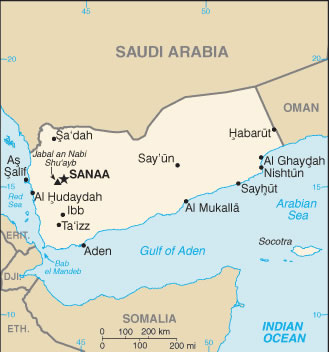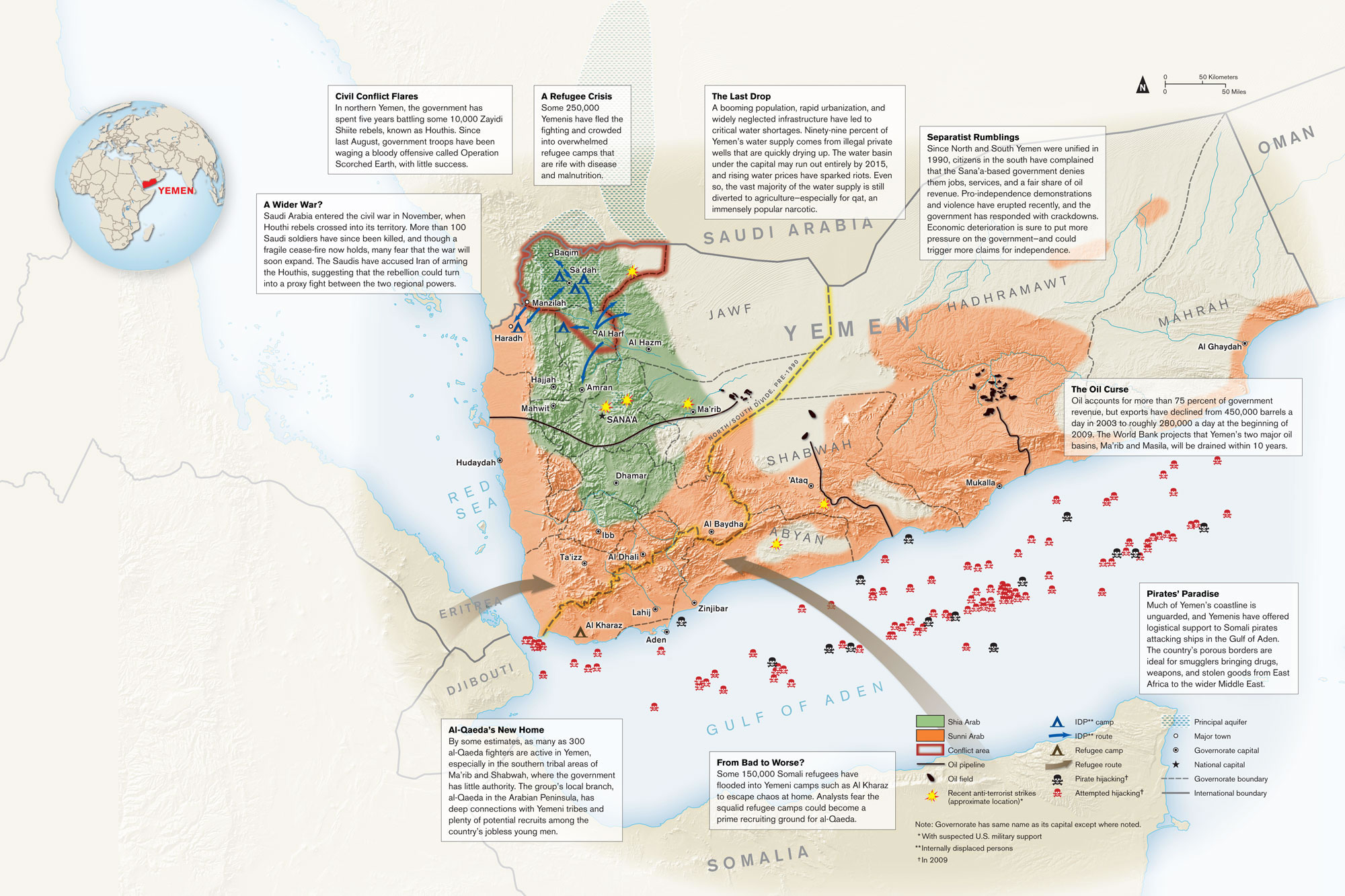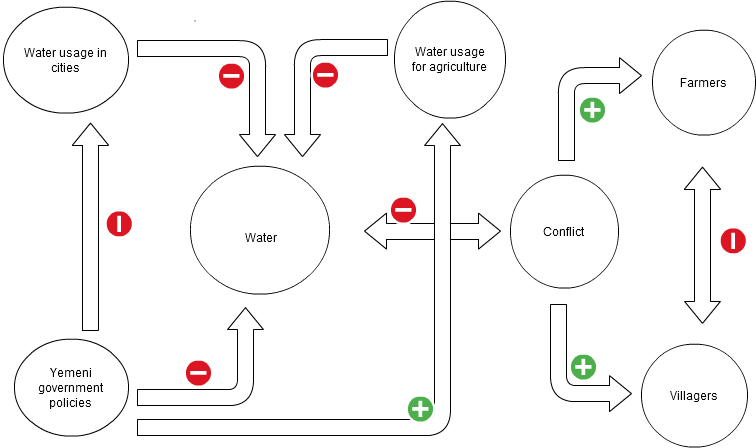1. Abstract
- Since the creation of the modern nation-state system, Yemen has been considered to be a water-stressed nation. The rate at which social and economic changes that have occurred have fast outpaced the ability of the government to control or regulate them; which has had a direct impact on water usage. The rate at which ground water is being extracted for agricultural purposes is unsustainable. Water markets in Yemen are well established and thriving but no steps have been taken for groundwater conservation (Ward). A growing population and economic advancement have produced a country that is struggling with water into a country that will run out of water.
- Yemen is a low-income country that relies mainly on declining oil resources. They have tried to diversify their economy as it is starting to fall due to unstable oil prices. However, the country faces long term challenges; including declining water resources and a high population growth rate (CIA). In addition, Yemen has a history of violence and a growing terrorist problem. All these problems combined have given Yemen the perfect conditions for climate induced conflict.
2. Description
-
One of the world's most water poor countries is steadily draining its water supply. Sanaa - which dates back to the sixth century B.C. - is projected to be one of the first cities to completly run out of water (see figure one). This water failure is expected to occur sometime around the year 2025 (UPI). Some researchers from Sanaa University found that between 70 - 80 percent of all rural conflicts in Yemen are due to water. Furthermore, the 2009 failed states report from the F oreign Policy magazine said that Yemen is "a perfect storm for state failure" because of disappearing oil and water reserves. In a report by the World Bank, Yemen is one of the most water-scarce countries in the world. To make matters worse, Yemen has an exploding population and has almost tripled in size since 1975 (Kasinof) (see below table).
oreign Policy magazine said that Yemen is "a perfect storm for state failure" because of disappearing oil and water reserves. In a report by the World Bank, Yemen is one of the most water-scarce countries in the world. To make matters worse, Yemen has an exploding population and has almost tripled in size since 1975 (Kasinof) (see below table).
- With a rising population and an increasing need for expanded water withdrawal; Yemen's future is one of civil war. Conflict in this country already happens at an alarming rate and social tension is expected to escalate even further, as water productivity declines. Along with social tensions, their is a disparity between agriculture and domestic use; agriculture uses 90% of the fresh water supply while the domestic sphere uses 7-8% (Al-Asbahi). This sharp difference in use could create a long-lasting, mild civil war between farmers and villagers.
- In Yemen, the water deficit is growing at about 5% per year (IRIN). The United Nations data on Yemen shows a 2.9% increase annually for population growth. A reducing water deficit and an expanding population; where much of the country already does not get water everyday is unsustainable. With this growth rate, people will be forced to migrate to places where there is already no room and that will increase social tensions - that already exists - creating massive problems for a country that some people think could become a failed state.
3. Duration
- The duration will be betweeen 2025 - 2040. This is an estimated duration for the conflict.
- Water conflicts have already started occuring in the country. However, they are small conflicts and the country is not yet in a full scale civil war - which is what the predicted duration time represents.
4. Location
| Continent |
Asia |
| Region |
Middle East - Asia |
| Country |
Yemen |
5. Actors
- The main actor is Yemen with some possible spill over into Saudi Arabia.
- Yemen's government is decentralized and faces many obstacles such as separatists and terrorist groups.
- The southern territories are ruled by local leaders - not President Ali Abdullah Saleh. The south is unhappy with the joining of North and South Yemen and about 100 people have been killed over the course of several months in regards to separation. The South claims that the Northern government takes resources out of the South and denies them political rights (The Washington Times). This is one such movement of many that could tear the country apart and part of that movement has claimed resources as one driving force.
- Yemen has also seen a rise of terrorist groups in the country - most notably Al-Qaeda. With a weak central government, these terrorists have been able to thrive and put pressure on the current government. If not careful, a full scale international war could occur. America and Great Britain announced that they would jointly finance counter-terrorism police efforts (Baker).
Top page
6. Type of Environmental Problem: Climate Change

Map by BBC News
7. Type of Habitat: Dry
- Arid / Dry
- Yemen has a mostly dry climate; along the west coast it is hot and humid. The nicest part of the country is in the western mountains which have a temperate climate. Heading back East, the climate turns into a hot, harsh desert (CIA).
8. Act and Harm Sites:
| Act Site |
Harm Site |
| Yemen |
Yemen |
Top Page
9. Type of Conflict
Figure 2: Map of Conflict, Refugees and Climate

Map by Carnegie Endowment (click on map for more information)
- This map shows a great explanation for climate change induced conflict in Yemen.
- In the North, there is a rebel group called the Houthi that continuously cross into Saudi Arabia while focusing their main violence against the central government of Yemen. Next, the South is an unwilling host to Al-Qaeda as well as a violent sepratist movement. Furthermore, there are refugees from Somolia coming into the southern region where they have their own refugees from internal conflicts. Furthermore, there is separatist rumblings in the North over oil and water resources. Lastly, the entire country is depleting its water resources and its major cities - most of which are located in the South/Central regions will run out of water first.
10. Level of Conflict: Medium
11. Fatality Level of Dispute (military and civilian fatalities)
- Most conflicts in Yemen have relatively small death tolls. In May 2009, 16 people were killed by police forces clashing with anti-government demonstrators (Economist). If we take this number for an average number of deaths for a civil war that lasts for 15 years, the fatality levels - both militarily and civilian - could be 2,880.
- Along with the death toll, tens of thousands of civilians would be displaced which would create the the potential for an even higher fatality number.
Top page
12. Environment-Conflict Link and Dynamics: Indirect
Figure 3: Yemen Diagram Map of Future Environmental Conflict

- Water policy is complex. The above diagram attempts to explain water policy in Yemen and how it could lead to potential conflict. In Yemen, there are no rivers so water comes from aquifers and little rainfall - which is the main water circle. As such, there is a finite amount of water for use in the country.
- Yemeni government policies favor water use in agriculture and not for domestic use. At the same time, Yemen does not currently have a sustainable water extraction policy which is leading to water depletion. The shortages in water have become so severe that it leads to conflict. The conflict is between the farmers and the villagers. The diagram is attempting to show that as conflict increases, water is depleted at a faster rate than it would otherwise be disappearing . This in turn leads to an escalation of conflict.
- Access to water - especially in arid lands - can be linked to climate change. One aspect of climate change is a temperature increase. This will lead to less water reaching its intended destination due to drought and flash floods. Also, an increase in temperature will make the air more humid keeping water in its gaseous form longer which will change weather patterns.
- According to the Intergovernmental Panel on Climate Change; Climate warming observed over the past several decades is
consistently associated with changes in a number of components
of the hydrological cycle and hydrological systems such
as: changing precipitation patterns, intensity and extremes;
widespread melting of snow and ice; increasing atmospheric
water vapour; increasing evaporation; and changes in soil
moisture and runoff.
- With poor water policy and an increase of temperature, usable, potable water will decrease. Social tension - on the conflict side - will increase the level of conflict that will result due to water scarcity.
13. Level of Strategic Interest: Regional
- The level of strategic interest is primarily Yemen
- There is some regional interest as conflict in Yemen have been known to cross borders.
14. Outcome of Dispute: In Progress
- The politics of the Middle East are not static and as such the outcome of any future war is unknown.
Top Page
15. Related ICE and TED Cases
Case 1. NILE Nile and Conflict , by Michele Ameri
Case 6. JORDAN Jordan River Dispute, by Lilach Grunfeld
Case 14. LITANI Litani River and Israel-Lebanon, by Angela Joy Moss
Case 53. CAUVERY Cauvery Water Dispute, by Alisa Pereria (January, 1998)
Case 56. LESWATER The Lesotho "Water Coup", by Alex Roney (November, 1997)
Case 71. BLUENILE Nile River Dispute, by Heather Hamilton
Case 98. INDOBANG India-Bangladesh Dispute on the Ganges River
Case 218. MEKONG-CHINA, The Drying of the Mekong River, by Nargiza Salidjanova
16. Relevant Websites and Literature
Al-Asbahi, Qahtan, Water Resources Information in Yemen, IWG-Environment http://unstats.un.org/unsd/environment/envpdf/pap_wasess3a3yemen.pdf (Accessed 9 December 2010)
Anonymous, Troubled Yemen, Economist http://www.economist.com/node/13766407 (Accessed 9 December 2010)
Baker, Peter, Politics, The New York Times http://www.nytimes.com/2010/01/03/us/politics/03address.html (Accessed 13 December 2010)
BBC News, Map Details Global Water Stress http://news.bbc.co.uk/2/hi/science/nature/5269296.stm (Accessed 10 December 2010)
Boucek, Christopher, Carnegie Endowment, http://carnegieendowment.org/publications/index.cfm?fa=view&id=40308 (Accessed 10 Decembet 2010)
IPCC, Bates, B.C., Z.W. Kundzewicz, S. Wu and J.P. Palutikof, Eds. IPCC Secretariat, Geneva, 210 pp. Available from IPCC Secretariat
IRIRN, Yemen: Unprecedented Water Rationing in Cities http://www.irinnews.org/report.aspx?ReportID=85734 (Accessed 10 December 2010)
Kasinof, Laura, Christian Science Monitor http://www.csmonitor.com/World/Middle-East/2009/1105/p06s13-wome.html (Accessed 9 December 2010)
News, The Washington Times http://www.washingtontimes.com/news/2010/may/21/yemeni-separatists-say-the-south-will-rise-again/?page=1 (Accessed 13 December 2010)
UPI, Energy Resources, Yemen's Water Crisis a Mideast Warning http://www.upi.com/Science_News/Resource-Wars/2009/10/29/Yemens-water-crisis-a-Mideast-warning/UPI-52511256844951/ (Accessed 10 December 2010)
Ward, Christopher, The British-Yemeni Society http://www.al-bab.com/bys/articles/ward01.htm (Accessed 9 December 2010)
Yemen, CIA World Fact Book https://www.cia.gov/library/publications/the-world-factbook/geos/ym.html#top (Accessed 29 November 2010) -
Yemeni Population Chart provided by Wikipedia via the Food and Agricultural Organization - Table 1 Graph
Flag and map courtesy of the CIA World Fact Book
Top page
[December 2010]
 II. Environment Aspects
II. Environment Aspects
 III. Conflict Aspects
III. Conflict Aspects IV. Environment and Conflict Overlap
IV. Environment and Conflict Overlap
 V. Related Information and Sources
V. Related Information and Sources